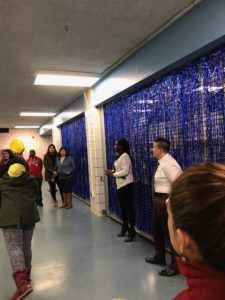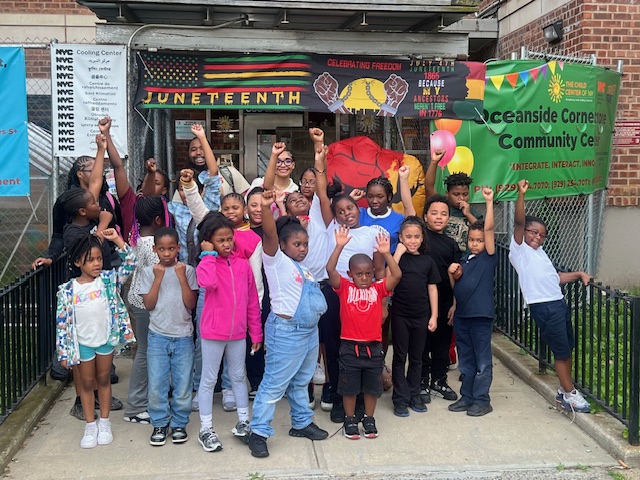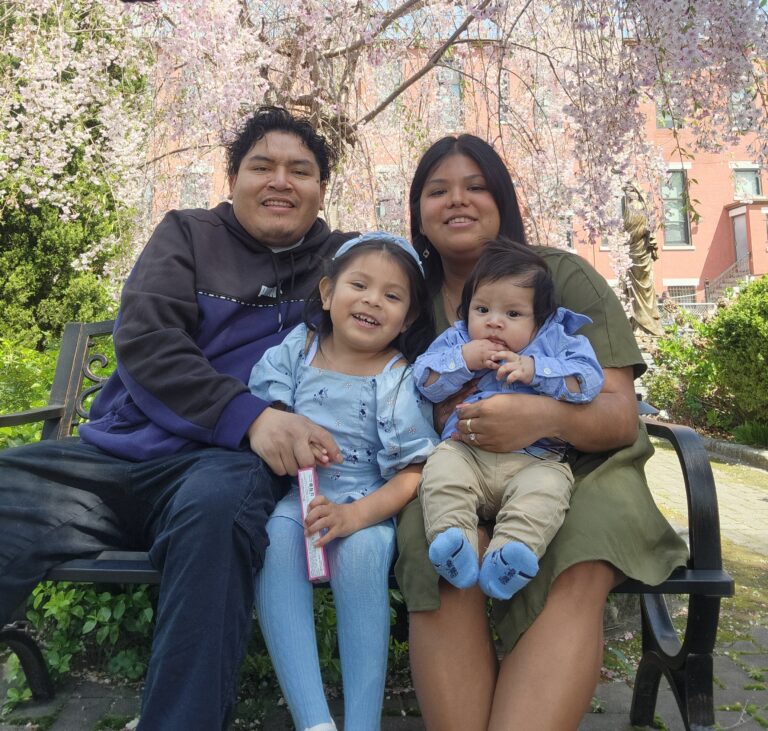Shows Students Have Had the Potential All Along
By Saran Shields, MSW
Community School Director, August Martin High School

Blog author Saran Shields with August Martin High School students
September is Attendance Awareness Month, and there’s no better place to spotlight the importance of attendance — and attendance efforts — than August Martin High School in South Jamaica, Queens.
In 2015, The Child Center of NY became the community school lead partner for August Martin High School, a “failing” school that various people and organizations have advocated to have shut down. The school had a graduation rate of just 25 percent, and, not unrelated, a 70 percent attendance rate, meaning that on any given school day, only 70 percent of students (whom we call “scholars”) showed up.
If scholars aren’t in school, they can’t learn, they can’t be inspired, and they can’t be engaged. The more school they miss, the harder it becomes to catch up, and the more hopeless it all starts to seem. This cycle causes dropping out to feel inevitable — hence the 25 percent graduation rate.
When I became Program Director at August Martin High School three years ago, I knew that addressing chronic absenteeism would be central to turning around these devastating statistics. My dedicated team and I took an aggressive, evidence-based, and holistic approach to addressing chronic absenteeism based on the following core principles:
- Understand the issue. Attendance matters. Chronic absenteeism is defined by the New York City Department of Education as 80-90 percent attendance; severe chronic absenteeism is defined as being below 80 percent. Sometimes when people hear 80-90 percent, they don’t think that’s an issue; they say, “Hey, 80 percent, that’s pretty good.” But it equates to missing about a month of school per academic year. At the high school level, chronic absenteeism is directly linked to an increased likelihood of dropping out. Conversely, research shows that when students attend school and are no longer chronically absent, they see academic gains and are more likely to graduate on time.
- Get to know the scholars who are chronically absent. Relationship-building is key. I know the school’s chronically absent scholars on paper before they ever walk through my door. I had a young lady come in here just last week who introduced herself by her first name, and she was shocked when I immediately supplied her last name. She said, “How did you know my name?” I knew who she was because I had pored over her transcript and other background information before she’d ever set foot in my office — and believe me, they all will eventually set foot in my office. When dealing with chronic absenteeism, the first step is always to meet with the scholar individually. They need to know that attendance matters, and I need to know how we can reengage them. There are a million reasons why a scholar may not be coming to school, and we have to find the one reason that will keep them coming. Is there a group or a sport or a class that interests them? What is the best environment for them? We want them to recognize their strengths — which they might not even know they have — and know that they can succeed. This type of process also means learning from our mistakes and ensuring that we give scholars every opportunity to be heard and play an active role in deciding what interventions need to be put in place in order to best support them.
-
Get to know the family. That’s just as important. Part of getting to know the scholar is getting to know her family. More often than not, that’s the key to finding out why they aren’t coming to school and how we can resolve the issue. Sometimes it’s a housing issue: the scholar used to live in the area, but the family got evicted and is now living in a shelter in the Bronx, making it very difficult to get to school. Sometimes it’s a child care issue: Mom has to work, and the scholar isn’t showing up for school because Mom doesn’t have anyone else to watch the little ones. Some are children of immigrants who grew up in a culture that doesn’t think it’s important for girls to be educated; or the parent doesn’t speak English and needs the child to accompany her to appointments to act as a translator. Sometimes it’s a lack of motivation — the scholar is home playing video games — coupled with a lack of parental support. Or she doesn’t have friends, feels like she isn’t liked, or is being bullied and just can’t bear to go to school. Perhaps there could be an addiction that has gone unaddressed.

Shields and AMHS Principal Rory Parnell welcome participants in a parent event.
We always have parent meetings when a child is chronically absent, because we want to make sure it is clear to parents that school is the child’s primary responsibility, and we find out how we can work together to help them ensure that this responsibility is met. If housing or issues relating to immigration are at work, we will put the family in touch with the appropriate social services to get the support they need, and we make sure we follow up. We offer addiction services here at The Child Center, or we can refer families elsewhere. If bad habits are to blame, we work with parents to change them. I had one scholar who spent all his time playing on his Xbox. The mom felt like she was losing control of the situation. In a meeting, we decided that we would keep the Xbox locked up at school. That was a solution that worked for this mom and this family. People often think that the problem is parents who don’t care. More often, parents feel stuck; they understand the situation they’re in, but they just don’t know the steps to take to get out of it. We make sure they know we are here to help.
- Assign success mentors. Connecting with a caring adult can make all the difference to a child who is chronically absent. The mentor can be a member of the school staff, a successful, relatable older scholar, or someone from the community with whom the scholar already feels a connection. Success mentors work with us to identify appropriate interventions to support and engage their mentees, and they meet with their mentees on their own. Most important, they are simply there for their mentees — checking in on them, making calls to the home when they are absent, listening to their concerns, and celebrating their improvements and accomplishments. It takes genuine care, time, and consistency. The NYC DOE asserts that success mentors have helped chronically absent youth gain up to a week or more of school and, in many cases, exit chronic absenteeism altogether. Our experience shows this to be true.
-
Create incentives. A pizza party for the class that wins the monthly First Period Attendance Competition might not sound like a lot, but it’s a part of the process to show scholars that we see their efforts, and they matter. A $25 gift card to a chronically absent teen who has zero latenesses, zero absences, and zero cuts for the semester might not seem like much, until you realize that one of the reasons that scholar isn’t coming to school is because Mom is working two jobs, and the scholar has been missing school to provide child care. Twenty-five dollars to Target won’t turn things around entirely for that family, but it shows we understand and appreciate their commitment and progress, and it works as an added incentive.
Bigger incentives are also integral to our strategy and success. We organize monthly college trips in which scholars can participate only if they had 100 percent attendance for that month. Past trips have included a three-day trip to visit Massachusetts colleges, including Amherst College and Boston University, and future trips include a visit to the University of Delaware on October 3. These trip act as incentives to attendance, and they also serve to show scholars possibilities they might not ever have considered for themselves. This year, six scholars were nominated to be a part of The Posse Foundation program. This was an eye-opening experience for many of our scholars, where the possibility of attending some of the best universities becomes a reality with 100 percent tuition paid for all four years, complete with mentorship and leadership development. This is a program that hadn’t been introduced to our scholars in more than six years.
- Change the culture. All of these efforts add up to the central principle that attendance comes before all things. We start with the incoming ninth grade class to establish good habits and maintain a zero tolerance policy. If a child is absent, we call the home to find out why and have a meeting when he returns to school. This also allowed us to focus our efforts this year on providing ninth graders with zero period instruction. Zero period uses a resiliency and restorative justice model that helps scholars get acclimated to their new environment while learning the skills necessary to be successful in high school. We also root our instruction in the eight core values of the school: advocacy, communication, collaboration, inquiry, integrity, leadership, perseverance, and scholarship.
I said it before, but I’ll say it again: School is every child’s primary responsibility, and we do whatever we need to do to instill that in every child and family.
These efforts are working. Within the last three years, my team has supported the school from turning a 70 percent attendance rate to an 82 percent rate, and an increase in the graduation rate from 24 percent to 73 percent. And August Martin High School is no longer considered a “failing” school.
While the collective increase shows our efforts are working, the personal stories show that the impact is truly immeasurable. One child had a 0 percent attendance rate. Within a year, that figure rose to 53 percent, and this year it’s above 80 percent. She passed her classes and Regents exams and has been able to join the softball team. She has more friends, and more reasons to come to school. As of right now, she’s a senior on track to graduate on time. That would’ve been hard to imagine a few years ago. It would have been easy to write this child off as a lost cause; but this work has shown that there is no such thing.
Attendance is a big job that takes a lot of time, and there is no shortcut around that. To say that we call every scholar who is absent until we reach the scholar or a family member to find out the reason for the absence, and then have a meeting, sounds simple enough, but when you realize we are talking about 100 individuals a day, you understand how overwhelming the task can be. Yet when you see the results, you also understand that it’s worth the effort, and so much more.
It is important to note that we are not in this work alone. We must bridge the resources available to us in order to be effective, and that comes with authentic partnerships. The partnerships formed with the teachers, support staff, and administration makes this work a lot easier. Attendance improvement is a huge endeavor, and it comes with setting high expectations and accountability measures for the team. This work cannot be done in isolation, but by working with all stakeholders — parents, school administration and staff, community members, school partner organizations, and of course, the scholars.
The NYC DOE Office of Community Schools’ attendance program is aptly called “Every Student, Every Day.” Because every day matters. And every scholar most certainly matters.






It is because of their commitment to attendance improvement that Saran and her team are in school each day — Monday through Friday — teaching Freshman seminar from 7:25-8:15 a.m. That is the start of their every day! Not only is it an early day, but also nights like “Back To School Night” require that these same staff are at work past 8:30 at night. While these special nights do not occur every week, they do occur 3-4 time a month. It is this passion and commitment to the work that allow Saran to lead her team with zeal and enthusiasm, committed to the success of every student at August Martin High School.